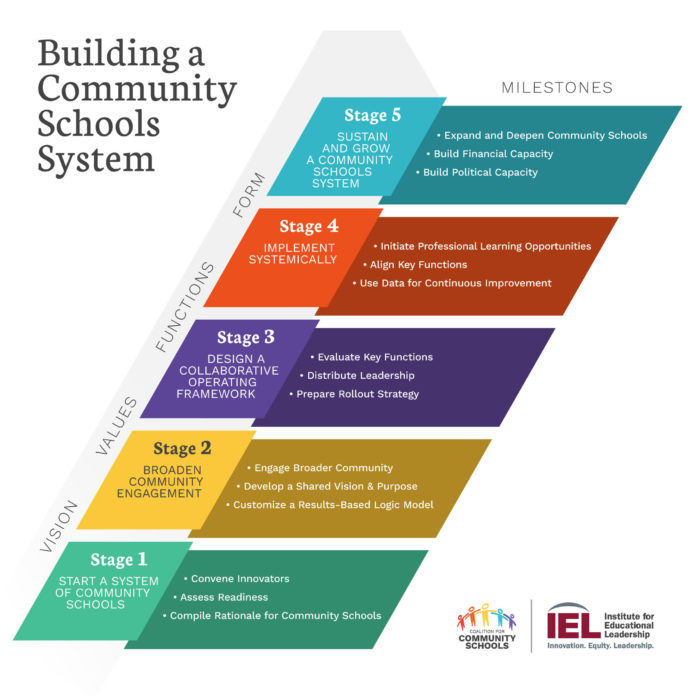
Overview:
The Community Schools movement is growing across the country and is a non-partisan solution that promotes local decision making to accelerate student success. The Community Schools strategy has evolved as a vehicle for whole-child, whole-family, whole-community prosperity, through intentional school-family-community partnerships. This strategy, “transforms a school into a place where educators, local community members, families, and students work together to strengthen conditions for student learning and healthy development. As partners, they organize in- and out-of-school resources, supports, and opportunities so that young people thrive.” At the system level, Community Schools bring together diverse actors—educators, young people, families, districts, service providers, community and faith-based organizations, civic and government entities, and businesses—to build a Collaborative Leadership Structure. The growing body of evidence about Community Schools, alongside the Community Schools Standards, show the essential role this strategy plays in changing the outcomes of young people and supporting thriving communities. It is from this context that we share the guide to Building a Community Schools System, an update to our 2011 Scale Up School and Community Partnerships Guide.
Building a Community Schools System is written for diverse audiences engaged in Community Schools efforts in their local contexts, from planning to integrate the Community Schools strategy in their district and community to existing initiatives of schools looking to further sustain, deepen, and perhaps, expand the strategy. The audiences for the guide are inclusive of leaders at school, district, community, civic, government, and business levels, funders, alongside families, young people, individual community members, grass-roots advocates.
We begin by introducing the concept of system-building through collaborative leadership structures and functions. We then introduce the five-stage process for building Community Schools systems, unpacking each stage within the subsequent Guide sections.
Download the Full Guide Here!
Download Intro only
Download Systems Visual here
Download Rubric here
Need help building your system? Email: CCS@iel.org

Associated milestones:
- Convene Early Adopters
- Assess Readiness
- Compile a Rationale for Community Schools
The stage 1 presupposes that the community has begun its journey of building a community school system by already having in place at least one community school. In Stage 1, a dedicated group of innovators interested in building a community schools system comes together to ask, What is our community’s capacity to launch a successful Community Schools system? The group could be promised of various community actors, such as community members, funders, state and local policymakers, direct-service providers, participants in similar initiatives. To evaluate the community readiness to begin the five-stage process, the innovators need to share knowledge, lived experiences, organizational expertise, and data, to develop a rationale for systems building and use their networks and spheres of influence to recruit additional partners.

Associated milestones:
- Engage Broader Community
- Develop a Shared Vision & Purpose
- Customize a Results-Based Logic Model
The innovators’ conversations lead to learning communities with the goal to authentically expand and deepen the leadership base reflective of the community. Together, representatives across sectors, institutions, organizations, inclusive of families, young people, and community members, commit to a board vision of the Community Schools ecosystem, develop clear results and customizes a results-based logic model to show how inputs interact and lead to agreed-upon results.

Associated milestones:
- Evaluate Key Functions
- Distribute Leadership
- Prepare Rollout Strategy
The designated leadership leaders will clarify roles, responsibilities, and accountability mechanisms of participating partners. One primary role is to select an intermediary organization that will provide operational and leadership support at the systems level, the vision, oversight, resource, and policy development for a sustainability initiative. The new initiative will also develop a strategy to address scope, site selection, site coordination, and professional learning opportunities.

Associated milestones:
- Initiate Professional Learning Opportunities
- Align Key Functions
- Use Data for Continuous Improvement
As the initiative builds on its professional learning opportunities, ensuring that all educators, partners, and leaders understand the transformational strategy being created. These partners will receive capacity building that will strengthen implementation. At the same time, initiative leaders will continue to align practices, policies, and processes across the system and school sites, as well as within the school district offices, and across agencies and partner organizations. Initiative leaders will collect and analyze data that are aligned with the results framework to support continuous improvement.

Associated milestones:
- Expand and Deepen Community Schools
- Build Financial Capacity
- Build Political Capacity
Sustaining and growing a system of community schools requires constant attention. Leaders should not take their eyes off key systemic challenges that can derail change efforts. Regular system scans across all four characteristics of effective systems building—shared ownership, spread, depth, and sustainability—can help identify areas that need attention. The initiative should refresh and strengthen its leadership, continuing to engage the community in a process of continuous improvement. The ecosystem must also attend to the key sustainability elements of financial and political capacity. Have the funds, leadership, and policy support ensures that the initiative will sustain across leadership changes.